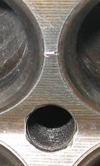Compacted versus cracked cylinder head?
 It's widely known that Compacted Graphite Iron (CGI) has a number of material properties which in certain applications make it the material of choice for cylinder blocks. So does this also apply to race engine cylinder heads and, if so, why?
It's widely known that Compacted Graphite Iron (CGI) has a number of material properties which in certain applications make it the material of choice for cylinder blocks. So does this also apply to race engine cylinder heads and, if so, why?
First let's look at some of the key criteria of a cylinder head. It has a number of functions, such as keeping gas and coolant inside, and providing the structure for assembling or bolting on other components - valve seats and guides, for example, but also camshafts. To do so, the cylinder head needs to withstand a number of different loads. During tensioning of the cylinder head bolts, assembly loads are put into the head structure. When the engine is fired up, the cyclic loading of the combustion forces (peak pressures) are added.
And last, but certainly not least, another significant load is the thermal loading due to the heating up and cooling down of the engine. The severity of this last load is often underestimated.
It doesn't need further explanation to say that the flame deck of the cylinder head will see the highest combined loading. The flame deck temperature will force the head to expand and deform into the combustion chamber. The higher temperature in the area of the exhaust valves leads to non-homogeneous deformation. Combustion will deform the head in exactly the opposite direction, leading to a constant cyclic deformation.
These loads can result in cylinder head flame deck cracks, especially in the valve bridges - the area between the ports which, because of their relatively small cross-sections, are most sensitive to damage.
So how does this mechanism work?
The difficulty with cylinder heads is that the head needs to be mounted as rigidly as possible to the crankcase to be able to withstand the combustion peak firing pressures, and prevent leakage of combustion gases or fluids. By doing so, the material is being limited in its ability to expand freely under thermal conditions.
Constraining this material when it's heating up will lead to thermal stresses in it. Up to a certain limit, this will lead to elastic strain, but when exceeding this limit, compressive plastic strain will occur. When the engine cools down the same happens, only in the opposite direction, leading to tensional stresses in the already plasticised areas. These stresses could again exceed the tensional yield limit, again creating plastic strains.
The material gets damaged from cyclic plastification, called thermo-mechanical fatigue (TMF). A number of factors directly influence the amount of plastic strain per cycle, namely the level of constraint, the highest material temperature, the time history of the thermal cycle and of course material properties. These plastic strains will increase from cycle to cycle. Due to its location and shape, the highest value will occur mostly in the intake - exhaust valve bridges, locally at the exhaust port side.
Some of these can be influenced by the design. The thermal conductivity, in combination with the coolant jacket layout, will determine the maximum temperature at the flame deck. In most race applications, aluminium is the material of choice, mainly because of its excellent thermal conductivity and the ease with which complex geometries can be cast in the water jackets.
The level of constraint is more difficult to control. Typically, a cylinder head has intake and exhaust ports, a water jacket (single or dual) and a number of bolts to mount the head to the block. This leaves almost no freedom to influence these constraints. Port orientation is normally the consequence of the valve train layout. The typical layout for race engines is a longitudinal port orientation, meaning intake valve on one side and the exhaust ports on the other side of the cylinder head's longitudinal axis, especially when using overhead camshafts.
In highly loaded motorsports applications in particular, with their many temperature cycles (engine on/off) - as in diesel road race engines - the loading can become too high for aluminium, leading to cracks in the flame deck. As long as these cracks do not reach the coolant jacket it will not be considered a problem, but if it does then a DNF cannot be avoided. In these cases, cast iron is often chosen as alternative. Having higher strength, grey cast iron is more robust against thermal fatigue cracks, although at the penalty of higher mass and worse heat conductivity.
Although not widely used at the moment, CGI can also be considered a very feasible solution. It has a significant higher mechanical stress than normal grey cast iron, and somewhat lower thermal conductivity.
In some cases, this might lead to a positive balance between these two major TMF-influencing parameters. In the early days, when CGI was far more expensive then normal grey cast iron, its use was not usually considered feasible. Nowadays, the costs of producing CGI have come down considerably due to the increased demand for this material.
CGI as cylinder head material is still something of an exception in race engine technology due to the fact that the combustion loading on cylinder heads is still rather modest, especially on gasoline engines, which means that aluminium will remain the material of choice. Diesel race engines, however, running significantly higher peak firing pressures than their gasoline equivalents, will most probably drive the developments for stronger head materials such as CGI.
And although, for example, the Audi Le Mans race diesels are running aluminium heads, for the lower-level race classes this development will be unaffordable. I therefore expect Compacted Graphite Iron to become one of the key cylinder head materials for high-performance (race) diesels in the near future.
Fig. 1 - Valve bridge crack between exhaust valve seats
Written by Dieter van der Put